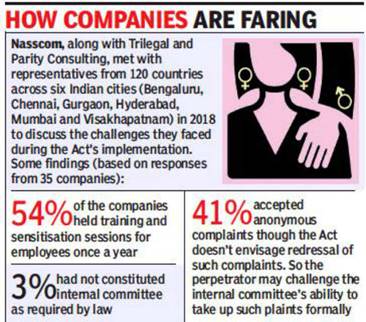



Include gender bias in scope of law to curb sexual harassment, says Congress member Rajeev Gowda
There is an urgent need to widen the scope of the Sexual Harassment of Women at Workplace (Prevention, Prohibition and Redressal) Act to include gender bias.
- Denial of promotions and exclusion from important tasks
- It can take the form of removal of responsibilities and withholding of resources.
- There are false accusations; there are whisper campaigns, subtle rumors passed on to other companies.
- Jurisdiction of internal complaints committees should be widened.
- They should have an NGO member and half of their total members should be women
- In case of multinational companies, they should include members from the Indian branches.
- The companies should publish the number of complaints of gender bias in their annual reports
- Increase the awareness of the Act among their employees.
The Sexual Harassment of Women at Workplace (Prevention, Prohibition and Redressal) Act, 2013 is a legislative act in India that seeks to protect women from sexual harassment at their place of work.
- The Act defines sexual harassment at the work place and creates a mechanism for redressal of complaints. It also provides safeguards against false or malicious charges.
- The Act also covers concepts of 'quid pro quo harassment' and 'hostile work environment' as forms of sexual harassment if it occurs in connection with an act or behavior of sexual harassment.
- The definition of "aggrieved woman", who will get protection under the Act is extremely wide to cover all women, irrespective of her age or employment status, whether in the organized or unorganized sectors, public or private and covers clients, customers and domestic workers as well.
- An employer has been defined as any person who is responsible for management, supervision, and control of the workplace and includes persons who formulate and administer policies of such an organization under Section 2(g).
- While the "workplace" in the Vishaka Guidelines is confined to the traditional office set-up where there is a clear employer-employee relationship, the Act goes much further to include organizations, department, office, branch unit etc. in the public and private sector, organized and unorganized, hospitals, nursing homes, educational institutions, sports institutes, stadiums, sports complex and any place visited by the employee during the course of employment including the transportation. Even non-traditional workplaces which involve tele-commuting will get covered under this law.
- The Committee is required to complete the inquiry within a time period of 90 days. On completion of the inquiry, the report will be sent to the employer or the District Officer, as the case may be, they are mandated to take action on the report within 60 days.
- Every employer is required to constitute an Internal Complaints Committee at each office or branch with 10 or more employees. The District Officer is required to constitute a Local Complaints Committee at each district, and if required at the block level.
- The Complaints Committees have the powers of civil courts for gathering evidence.
- The Complaints Committees are required to provide for conciliation before initiating an inquiry, if requested by the complainant.
- The inquiry process under the Act should be confidential and the Act lays down a penalty of Rs 5000 on the person who has breached confidentiality.
- Penalties have been prescribed for employers. Non-compliance with the provisions of the Act shall be punishable with a fine of up to ₹ 50,000. Repeated violations may lead to higher penalties and cancellation of license or deregistration to conduct business.
- Government can order an officer to inspect workplace and records related to sexual harassment in any organization.

- However, employers often receive complaints that claim to be about sexual harassment but actually are complaints of general harassment.
- There is time bound on the filing of the complaint. Under the law there is 3 month requirement and committee can extend it to further 3 months. This is a big challenge.
- Definition of workplaces is continuously changing. Whether office party or non-official informal social media groups will be considered as workplace is difficult to ascertain.
- Composition of Internal complaint committee is also an issue as committee will not take actions against a senior employee.
- The Act and the Rules do not provide any specific guidelines relating to what will qualify as evidence in a case of sexual harassment. Most instances of sexual harassment take place in private, which may not result in any written evidence or first-hand witnesses.
- The Act and Rules do not contain any provision to address anonymous complaints. But in a patriarchal society like India, anonymous complaint should be allowed to file.
Mr. Trump is expected to visit India on February 24, 25. For a President who markets himself as a negotiator and closer of deals, signing a trade deal while in India is likely to be an important aspect of his trip.
- The U.S. side is “disappointed” about the tariffs announced in the Union Budget, particularly the import cess on medical devices.
- US wanted a deal on dairy products and elimination of tariffs on ICT products.
- India is seeking restoration of India’s benefits under the U.S.’s preferential trade system, the Generalized System of Preferences (GSP).
- India’s leopard population may be only a tenth of what it was a little over a century ago.
- The leopard population suffered a possibly human-induced population decline of 75% to 90% between 120 and 200 years ago.
- Population decline in a species seen as wide-ranging and locally abundant suggest that leopards demand conservation attention just like tigers.
- Unlike the tiger census held once in four years, there is no dedicated census for the leopard.
- Conflicts with humans
- Poaching
- Habitat loss to availability of prey
- An initiative similar to ‘Project Tiger’ is required for leopards.
- There are three type of leopard in India. Indian leopard, Snow Leopard and Clouded leopard.
- Indian leopard is listed as vulnerable in IUCN red list.
- Clouded leopard is mainly found in Assam, northern West Bengal, Sikkim, Arunachal Pradesh, Manipur, Meghalaya, Mizoram, Nagaland, and Tripura.
- Clouded leopard status is Vulnerable in IUCN red list.
- Snow leopard in found in Himalayan states.
- It is also vulnerable in IUCN red list.
- Global Snow Leopard & Ecosystem Protection (GSLEP) Program is focusing on preservation of snow leopard.
- It will be conducting an orientation and sensitisation programme for all coalmine owners in East Jaintia Hills district toward granting of prospecting license.
- It will prepare a geological report and feasibility study.
- It would also be granting mining lease under scientific coal mining plan according to the Mines and Minerals (Development and Regulation) Act, 1957, and the Mineral Concession Rules, 1960.
- It is in pursuance to the Supreme Court order on July 3, 2019, to facilitate systematic, safe, scientific and planned utilization of mineral resources and to streamline mineral-based development of the State.
- The National Green Tribunal had banned ecologically unsafe and hazardous rat-hole coal mining in Meghalaya from April 14 while allowing the transportation of already extracted coal up to a certain period.
- The stash of 4, 61,976 card payment details went up for sale on Joker’s Stash. The data is suspected to have been collected from phishing rackets, which are on the rise in India over the last few years.
- The underground market value of the database is estimated at more than $4.2 million.
- The source of this batch currently remains unknown.
- Upon the discovery of this database, Group-IB has immediately informed the Indian Computer Emergency Response Team (CERT-In) about the sale of the payment records.
- The details are comprehensive in nature and include card numbers, expiration dates, and CVV/CVC codes.
- Earlier Company found card dumps (the information contained in the card magnetic stripe), which can be stolen through the compromise of offline POS terminals.
- Such type of data is likely to have been compromised online — with the use of phishing, malware, or JS-sniffers.
- JavaScript or JS-Sniffers are programmes used for stealing credit and debit card information from e-commerce website.
- Sharang is the 130mm artillery gun ‘up-gunned’ to 155mm, 45-caliber up gunning based on the Army’s tender.
- The gun’s range has now gone from 27km to over 36km with the upgrade.
- It also has more explosive capability and hence and more damage potential

- Light Utility Helicopter (LUH) will replace the ageing fleet of Cheetah and Chetak helicopters.
- LUH is a single engine, light weight, highly agile 3-ton utility helicopter, indigenously designed and developed to meet the operational requirements of Indian Army and the Indian Air Force.
- Performance of basic configuration of LUH in all terrains and under all weather conditions was satisfactory and HAL will towards the next phase of integrating and flight testing of mission role equipment on LUH.

© 2025 iasgyan. All right reserved